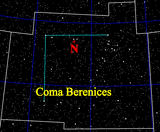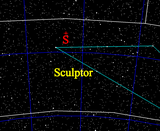
The galactic coordinate system is a celestial coordinate system in spherical coordinates, with the Sun as its center, the primary direction aligned with the approximate center of the Milky Way Galaxy, and the fundamental plane parallel to an approximation of the galactic plane but offset to its north. It uses the right-handed convention, meaning that coordinates are positive toward the north and toward the east in the fundamental plane.[1]
YouTube Encyclopedic
-
1/5Views:36 4671 8721 7652 58679 925
-
Where is it? Celestial coordinates explained
-
Teach Astronomy - Galactic Coordinates
-
Galactic Coordinate System
-
The Celestial Coordinate Systems Dr.Jayakrishnan K
-
The Sky Part 1: Local Sky and Alt-Az / Horizon Coordinates
Transcription
Spherical coordinates
Galactic longitude

Longitude (symbol l) measures the angular distance of an object eastward along the galactic equator from the Galactic Center. Analogous to terrestrial longitude, galactic longitude is usually measured in degrees (°).
Galactic latitude
Latitude (symbol b) measures the angle of an object northward of the galactic equator (or midplane) as viewed from Earth. Analogous to terrestrial latitude, galactic latitude is usually measured in degrees (°).
Definition
The first galactic coordinate system was used by William Herschel in 1785. A number of different coordinate systems, each differing by a few degrees, were used until 1932, when Lund Observatory assembled a set of conversion tables that defined a standard galactic coordinate system based on a galactic north pole at RA 12h 40m, dec +28° (in the B1900.0 epoch convention) and a 0° longitude at the point where the galactic plane and equatorial plane intersected.[1]
In 1958, the International Astronomical Union (IAU) defined the galactic coordinate system in reference to radio observations of galactic neutral hydrogen through the hydrogen line, changing the definition of the Galactic longitude by 32° and the latitude by 1.5°.[1] In the equatorial coordinate system, for equinox and equator of 1950.0, the north galactic pole is defined at right ascension 12h 49m, declination +27.4°, in the constellation Coma Berenices, with a probable error of ±0.1°.[2] Longitude 0° is the great semicircle that originates from this point along the line in position angle 123° with respect to the equatorial pole. The galactic longitude increases in the same direction as right ascension. Galactic latitude is positive towards the north galactic pole, with a plane passing through the Sun and parallel to the galactic equator being 0°, whilst the poles are ±90°.[3] Based on this definition, the galactic poles and equator can be found from spherical trigonometry and can be precessed to other epochs; see the table.
| Right ascension | Declination | Constellation | ||||
| North Pole +90° latitude |
12h 51.4m | +27.13° | Coma Berenices (near 31 Com) | |||
| South Pole −90° latitude |
0h 51.4m | −27.13° | Sculptor (near NGC 288) | |||
| Center 0° longitude |
17h 45.6m | −28.94° | Sagittarius (in Sagittarius A) | |||
| Anticenter 180° longitude |
5h 45.6m | +28.94° | Auriga (near HIP 27180) | |||
| ||||||

The IAU recommended that during the transition period from the old, pre-1958 system to the new, the old longitude and latitude should be designated lI and bI while the new should be designated lII and bII.[3] This convention is occasionally seen.[4]
Radio source Sagittarius A*, which is the best physical marker of the true Galactic Center, is located at 17h 45m 40.0409s, −29° 00′ 28.118″ (J2000).[2] Rounded to the same number of digits as the table, 17h 45.7m, −29.01° (J2000), there is an offset of about 0.07° from the defined coordinate center, well within the 1958 error estimate of ±0.1°. Due to the Sun's position, which currently lies 56.75±6.20 ly north of the midplane, and the heliocentric definition adopted by the IAU, the galactic coordinates of Sgr A* are latitude +0° 07′ 12″ south, longitude 0° 04′ 06″. Since as defined the galactic coordinate system does not rotate with time, Sgr A* is actually decreasing in longitude at the rate of galactic rotation at the sun, Ω, approximately 5.7 milliarcseconds per year (see Oort constants).
Conversion between equatorial and galactic coordinates
An object's location expressed in the equatorial coordinate system can be transformed into the galactic coordinate system. In these equations, α is right ascension, δ is declination. NGP refers to the coordinate values of the north galactic pole and NCP to those of the north celestial pole.[5]
The reverse (galactic to equatorial) can also be accomplished with the following conversion formulas.
Where:
Rectangular coordinates
In some applications use is made of rectangular coordinates based on galactic longitude and latitude and distance. In some work regarding the distant past or future the galactic coordinate system is taken as rotating so that the x-axis always goes to the centre of the galaxy.[6]
There are two major rectangular variations of galactic coordinates, commonly used for computing space velocities of galactic objects. In these systems the xyz-axes are designated UVW, but the definitions vary by author. In one system, the U axis is directed toward the Galactic Center (l = 0°), and it is a right-handed system (positive towards the east and towards the north galactic pole); in the other, the U axis is directed toward the galactic anticenter (l = 180°), and it is a left-handed system (positive towards the east and towards the north galactic pole).[7]

In the constellations
The galactic equator runs through the following constellations:[8]
See also
- Galactic quadrant – One of four circular sectors of the Milky Way galaxy
- Supergalactic coordinate system – coordinate system
- Astronomical coordinate systems – System for specifying positions of celestial objects
- Galaxy formation and evolution – From a homogeneous beginning, the formation of the first galaxies, the way galaxies change over time
- Milky Way – Galaxy containing the Solar System
References
- ^ a b c d Blaauw, A.; Gum, C.S.; Pawsey, J.L.; Westerhout, G. (1960). "The new IAU system of galactic coordinates (1958 revision)". Monthly Notices of the Royal Astronomical Society. 121 (2): 123. Bibcode:1960MNRAS.121..123B. doi:10.1093/mnras/121.2.123.
- ^ a b Reid, M.J.; Brunthaler, A. (2004). "The Proper Motion of Sagittarius A*". The Astrophysical Journal. 616 (2): 874, 883. arXiv:astro-ph/0408107. Bibcode:2004ApJ...616..872R. doi:10.1086/424960. S2CID 16568545.
- ^ a b James Binney, Michael Merrifield (1998). Galactic Astronomy. Princeton University Press. pp. 30–31. ISBN 0-691-02565-7.
- ^ For example in Kogut, A.; et al. (1993). "Dipole Anisotropy in the COBE Differential Microwave Radiometers First-Year Sky Maps". Astrophysical Journal. 419: 1. arXiv:astro-ph/9312056. Bibcode:1993ApJ...419....1K. doi:10.1086/173453.
- ^ Carroll, Bradley; Ostlie, Dale (2007). An Introduction to Modern Astrophysics (2nd ed.). Pearson Addison-Wesley. pp. 900–901. ISBN 978-0805304022.
- ^ For example Bobylev, Vadim V. (March 2010). "Searching for Stars Closely Encountering with the Solar System". Astronomy Letters. 36 (3): 220–226. arXiv:1003.2160. Bibcode:2010AstL...36..220B. doi:10.1134/S1063773710030060. S2CID 118374161.
- ^ Johnson, Dean R.H.; Soderblom, David R. (1987). "Calculating galactic space velocities and their uncertainties, with an application to the Ursa Major group". Astronomical Journal. 93: 864. Bibcode:1987AJ.....93..864J. doi:10.1086/114370.
- ^ "SEDS Milky Way Constellations".
External links
- Universal coordinate converter.
- Galactic Coordinate System - Wolfram Demonstration
- Galactic coordinates, The Internet Encyclopedia of Science
- Fiona Vincent, Positional Astronomy: Galactic coordinates, University of St Andrews
- An Atlas of the Universe







